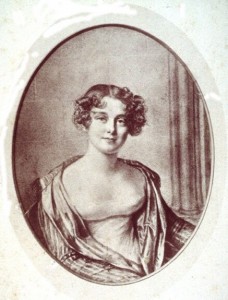
Lady Jane Franklin, audacious traveller and governor’s wife, “affable, welcoming and charming”2, provided a bright inspiration for colonial musicians. Courtesy W L Crowther Library, Tasmanian Archive and Heritage Office.3
“…the assemblage was brilliant, the punch superlative, and the dancing extremely active, if not elegant.”
Jane Franklin1,
Government House, Hobart, 1838
Most histories of the Franklins concentrate on Sir John’s explorations and disappearance in the Arctic, supplemented with stories of Lady Jane’s devotion to discovering his fate. Here we present the Franklins’ musical legacy, revealing a genial and cultured presence which inspired local musicians to pay homage to the “universally beloved & respected” 4 Sir John and Lady Jane Franklin.
Jane Griffins was born in London, 1791. She was the second daughter of John Griffin and grew up with her two sisters, Frances and Mary in the family home at 21 Bedford Place. As a well-bred young lady, she was accomplished in the art of dance and her journals include frequent accounts of dancing and balls. The continuous wars with France throughout her childhood meant that Jane had little exposure to continental dance fashions. In 1815, when Napoleon was finally defeated and peace was restored with France, Jane’s father embarked on a grand tour with his family. For the next two years, Jane remained on the continent becoming familiar with the latest innovations in dance, the quadrille and the waltz.
“…in Geneva she met Adolphe Butini, a clever, vivacious young man. She danced with him at a ball, wearing a white satin dress decorated with lace, ribbon and net , and a crimson velvet corset tied behind with white ribbons. There were more dances and outings, and Jane thoroughly enjoyed herself.”5
On returning to England, Jane enjoyed a privileged life of parties, concerts and dancing, and attended art exhibitions and scientific lectures. At the age of 37, she married Captain John Franklin, an explorer famous for his 1819-22 expedition searching for the North-West Passage. Franklin enjoyed the role of a “favourite hero”6 and his family noted that his company was eagerly sought whenever he attended parties and balls. Given “such demand by the ladies” 7 at balls, he was no doubt an accomplished dancer.
After commanding another expedition to the Artic in 1824-8, John was knighted and subsequently accepted the position of Lieutenant-Governor of Van Diemen’s Land. He and Jane left England on 24 August 1836 aboard the ship Fairlie.
“Once they were in calmer and warmer waters Sir John’s piano was brought on deck and with Miss Kracoft [Cracroft] as “chief musician”, 7 or 8 couples danced country dances, quadrilles, etc”.8
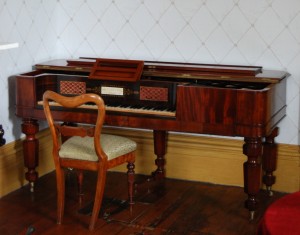
Lady Franklin’s piano, ordered from John Broadwood & Sons of London in c. 1836, has been loaned to Narryna Heritage Museum, Battery Point, Hobart, by a private collector.9
As governor of the small colony, Franklin was expected to hold lavish balls, particularly in honour of the monarch’s birthday. Jane did not always delight in these events, as they entailed a great deal of work, with between 300 and 500 people in attendance. The quality of dancing for one accustomed to the high society of London must have seemed greatly inferior, as the opening quote suggests.
“…the assemblage was brilliant, the punch superlative, and the dancing extremely active, if not elegant.”
Government House, Hobart, 1838 11
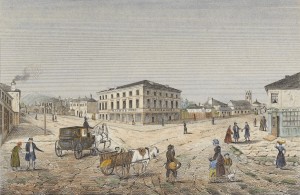
Hobart Town in 1840 by E. Buchner. Courtesy Allport Library and Museum of Fine Arts, Tasmanian Archive and Heritage Office.12
The initial entertainments given by the Franklins reflected an open approach to the diverse society of Van Diemen’s Land; however, one of the greatest problems for colonial governors was the acceptance of ex-convicts into polite society. Soon the Franklins realised that not everyone was acceptable and they devised a grading system of four levels for suitable association. This offended everyone apart from those in the elite group and lead to much unhappiness in the social scene.
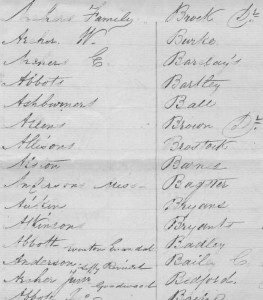
The Library at the University of Tasmania has a long, hand-written list of guests invited to a ball in 183713. Jane Franklin’s main problems with balls rose when the question of guests’ ‘want of character’ 14 arose – and she had high standards of behaviour.
Despite this unsatisfactory arrangement, the Franklins seem to have been popular as evidenced by the enormous donations given by the community to fund the search for Sir John when he became lost near the North Pole in 1847. Alison Alexander writes in The Ambitions of Jane Franklin that “The convicts loved Sir John, and still praised him decades later.”15
In 1839 Lady Franklin undertook a most adventurous excursion becoming the first lady to travel overland from Melbourne to Sydney. The “Sydney newspapers covered the trip in detail, almost all praising Lady Franklin’s ‘difficult and extraordinary’ trip….a lady undergoing such perils was depicted as a good example to others.”16
The Sydney composer, Francis Ellard, composed a suite of National Country Dances for 184317 with eleven tunes named in honour of leading Australian ladies, one of whom was Lady Franklin. The music for these dances is available in the National Library of Australia; unfortunately, instructions for the dances have not been located. A beautiful recording is available on Australia Unite! The Road to Federation produced by the State Orchestra of Victoria, conducted by Richard Divall18.
Although Jane was not keen on the study of music herself, she was keen to foster culture and motivated others in the pursuit of education and the arts. One protégé was Henry Mundy, an artist and music teacher, who used Lady Franklin’s piano as he composed several sets of quadrilles and waltzes. His Eight Sets of Quadrilles was published in London in 1838, dedicated to Mundy’s students at Ellinthorpe Hall, near Ross, Tasmania, a fashionable school for young ladies The only copy known to have survived was donated to the Queen Victoria Museum and Art Gallery in Launceston, Tasmania in 2014, having been discovered by chance in a second hand shop several years previously. The music has been republished in Colonial Artist Henry Mundy and His Music by Peter C. Sims.19
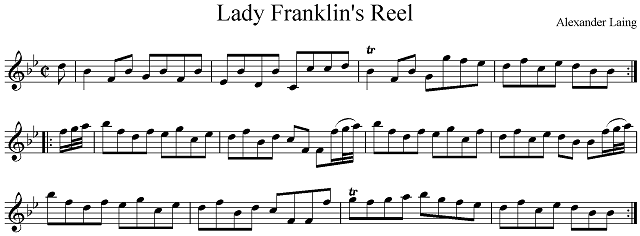
Alexander Laing used the tune The Countess of Sutherland’s Reel, (Daniel Dow, 1773) renaming it Lady Franklin’s Reel20. It was a common practice at the time to borrow tunes and dedicate them to prominent people.
Alexander Laing, a talented Scottish fiddle player who was transported to Tasmania in 1815, dedicated a lively reel to Lady Franklin and also composed a strathspey entitled Sir John Franklin near the North Pole. Both tunes were recently published (2010) in a collection of Laing’s original tunes, On the Fiddle From Scotland to Tasmania. The Life and Music of Alexander Laing (1792-1868) convict, Constable, Fiddler and Composer. Peter MacFie provides this description of the strathspey: “The cheerfulness of this tune suggests it was written while the Franklins were in the colony, and before Sir John returned to the icy wastes of the Canadian coast…”
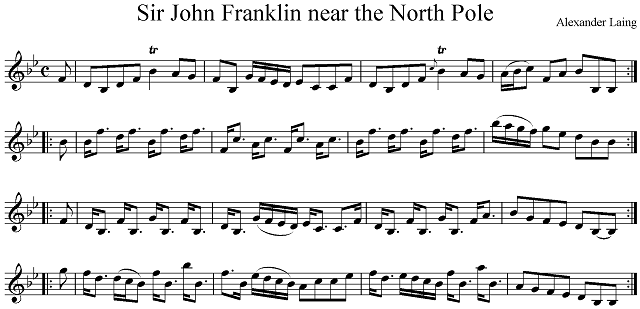
Sir John Franklin near the North Pole is an original composition of Alexander Laing. The full manuscript of his work is held in the Archives Office of Tasmania.21
The Franklins left Tasmania in 1843. Two years later, Sir John embarked on another expedition to find the North-West passage and disappeared, leaving a mystery unresolved for years. Jane continued to organise search parties in the hope of discovering the fate of her husband.
Lady Franklin died in England on 18 July 1875.
A biographer22 of the Franklins’ time in Tasmania wrote, their “most constructive work was in attempting to foster culture and to fabricate social cement.” This musical legacy of Sir John and Lady Jane Franklin provides a memorial to their residence in the colony, and a celebration of the culture which they strove to foster.
________________________________________________________________
Sources
1Alexander, Alison. (2013). The Ambitions of Jane Franklin. Victorian Lady Adventurer. Sydney: Allen & Unwin. p.19
2ibid., p.74
3Negelen, Joseph Mathias. (18 Jun 1792 – 11 Jun 1870). Portrait of Jane Griffin, aged 24. Later Lady Jane Franklin. Lithograph, after 1816 chalk drawing by Amelie Romilly (21 Mar 1788 – 2 Dec 1875). Tasmanian Archive and Heritage Office Collection. http://stors.tas.gov.au/AB713-1-11386
4Alexander, Alison. (2013). p.185
5ibid., p.9
6ibid., p.22
7ibid., p.23
8Henty, William. (26 Aug.1836 – 6 Jan.1837) Journal of his voyage on the “Fairlie” to V.D.L. http://eprints.utas.edu.au/10943/2/henty.pdf
9Lady Franklin’s piano, ordered from John Broadwood & Sons of London in c. 1836, has been loaned to Narryna Heritage Museum, Battery Point, Hobart, by a private collector. The piano is believed to be the instrument on which colonial artist and composer, Henry Mundy (c. 1798-1848, active in Tasmania from 1831) composed music for the ballroom dance, the quadrilles, while he was drawing and dancing master at Ellenthorpe Hall, Ross.
10“Sophia Cracroft” by Unknown – http://thegardenisland.com/lifestyles/lady-jane-franklin-and-sophia-cracroft-visit-kaua-i/article_d0b0431a-fa52-11e1-8f16-0019bb2963f4.html?mode=image&photo=0. Licensed under Public Domain via Wikimedia Commons – http://commons.wikimedia.org/wiki/File:Sophia_Cracroft.jpg#/media/File:Sophia_Cracroft.jpg
11Alexander, Alison. (2013) p.19
12Buchner, E. Hobart Town. [S.l.] : C.W. Medau & Co., [184-?]. Allport Library and Museum of Fine Arts, Tasmanian Archive and Heritage Office. http://stors.tas.gov.au/AUTAS001131821308j2k
13Ball list. Courtesy of the University of Tasmania, Special & Rare Collections, RS 18/10 http://eprints.utas.edu.au/10585/
14Alexander, Alison. (2013). p. 68
15ibid., p. 156
16ibid., p. 149
17Ellard, Frederick. (1843). National Country Dances no. 4. The Australian Ladies Country Dances. http://trove.nla.gov.au/work/156931401?q=Ellard+country+dances+ladies&c=music&versionId=171071612
18Divall, Richard, Quaife, Merlyn, Bolton-Wood, John, State Orchestra of Victoria. (2001). Australia unite! the road to federation. Songs and dances of colonial Australia. Sound recording [CD]. Sydney, NSW : ABC Classics
19Sims, Peter C. (2014). Colonial artist Henry Mundy and his music. Contains (work), Eight sets of quadrilles for the pianoforte. Quoiba, Tasmania
20MacFie, Peter and Gadd, Steve & Marjorie. (2010) On the Fiddle From Scotland to Tasmania. The Life and Music of Alexander Laing (1792-1868) convict, Constable, Fiddler and Composer. Dulcot, Tasmania. http://www.petermacfiehistorian.net.au/books/OnTheFiddleFromScotlandToTasmania/manuscript-tunes.html
also see http://www.musictasmania.com.au/projects
21Laing, Alexander. (1792 – 1868) Copy of music manuscript. Tasmanian Archive Office. http://search.archives.tas.gov.au/default.aspx?detail=1&type=I&id=NS548/1/1
22Fitzpatrick, Kathleen. (1966). Franklin, Sir John (1786–1847) Australian Dictionary of Biography, Volume 1, (MUP).
________________________________________________________________________
The information on this website www.historicaldance.au may be copied for personal use only, and must be acknowledged as from this website. It may not be reproduced for publication without prior permission from Heather Blasdale-Clarke.
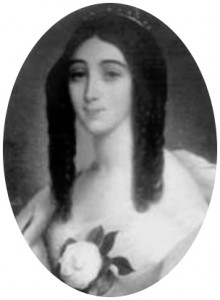


4 Responses to Lady Franklin’s Reel